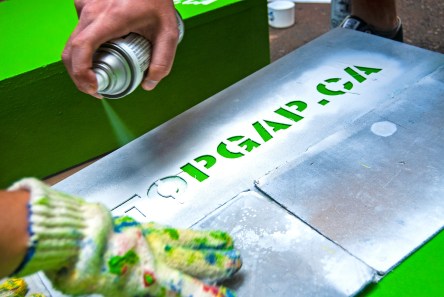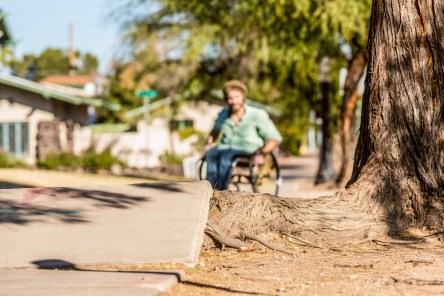If you see the picture on the right and think “wheelchair ramps,” you’ve only seen the tip of the iceberg. It’s also a stroller ramp, an aid for people with chronic joint pain, a ramp for tiny kids with tiny legs, and a blessing for CrossFitters on leg day. In short, all sorts of people appreciate a gradual transition between spaces. Toronto-based StopGap helps businesses and organizations make such transitions possible at low or no cost while broadening the conversations on access and equity. 1 or 1,000 Steps, Same Problem Although Luke Anderson is an engineer, he had never paid much attention to the multitudinous businesses, places of worship, and public structures that used stairs to transition between spaces. Once Anderson began using a wheelchair daily, he noticed just how many buildings failed to offer barrier-free access to visitors and occupants. While such access is essential for wheelchair users, others would benefit from barrier-free entry as well. The “curb cut affect” defines that when something is made easier for one population, it often helps members of other populations. Ramps for wheelchair users would also benefit delivery persons, the elderly, and others who are hindered by stairs. Anderson, along with his friend and coworker Michael Hopkins, began to plan a way to bridge the gap between accessibility and the costs needed to improve accessibility. Addressing the Gap Anderson is now the executive director and co-founder of StopGap, which aims to break down barriers one step at a time. StopGap Foundation works to create a world where every person can access every space. As a result, the non-profit is creating a world where everyone can live a life of independence, spontaneity, and ultimate fulfillment. But the organization didn’t begin with such grandiose plans. “I thought it...
ADA in Multifamily
Cost of Non-Compliance
I’ve been a proud Atlanta resident for 24 years. While much of that time was spent in the car-dependent suburbs, recent years have offered the opportunity to explore the bustling city as a pedestrian. It was during a trip to Piedmont Park (the largest park within Atlanta city limits) that I noticed a problem that has plagued city dwellers for decades: precarious pavement. Cracked concrete slabs jut several inches into the air, forced upward by the roots of established trees and erosion. Those raised surfaces were accompanied by deep potholes and portions of missing concrete. It was an unpleasant ride on my mountain bike. I could only imagine what it must be like on foot or in a wheelchair. Others have had similar thoughts. On June 11, three wheelchair users filed a class action lawsuit against the city of Atlanta. The suit asserts that the city’s walkway infrastructure does not uphold the Americans with Disabilities Act (ADA) statutes. The hazardous walkways make navigating pedestrian thoroughfares dangerous. In many areas, pedestrians must enter the street and contend with automobile traffic just to get around. A win seems promising for the wheelchair users. Several major cities have emerged from similar lawsuits by paying billions for repairs. Los Angeles, for example, settled a suit in 2015 for $1.3 billion in repairs over the span of 30 years. Avoid Lawsuits. Be Proactive About ADA Compliance. If major cities are not exempt from ADA noncompliance lawsuits, neither are you. Residents are demanding their rights at multifamily properties, too. In 2012, The Department of Justice announced one of the largest settlements to date: the owner of 32 properties had to pay $10,250,000 into an accessibility fund to correct noncompliance issues. The owners also paid a $250,000 civic penalty. Correcting the...


